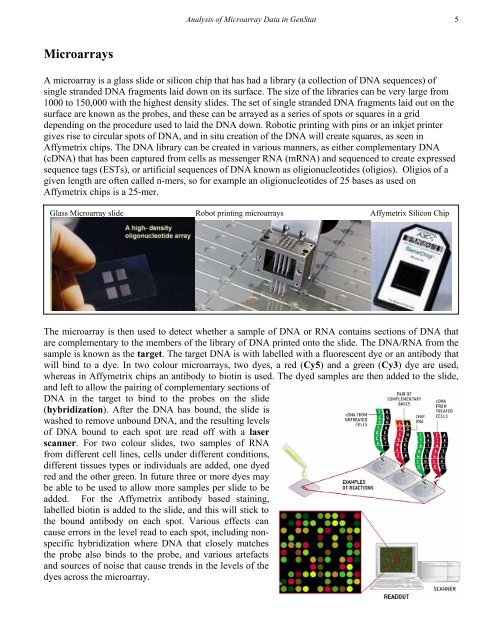Analysis of microarray data - VSN International
Analysis of microarray data - VSN International
Analysis of microarray data - VSN International
- No tags were found...
You also want an ePaper? Increase the reach of your titles
YUMPU automatically turns print PDFs into web optimized ePapers that Google loves.
<strong>Analysis</strong> <strong>of</strong> Microarray Data in GenStat 5MicroarraysA <strong>microarray</strong> is a glass slide or silicon chip that has had a library (a collection <strong>of</strong> DNA sequences) <strong>of</strong>single stranded DNA fragments laid down on its surface. The size <strong>of</strong> the libraries can be very large from1000 to 150,000 with the highest density slides. The set <strong>of</strong> single stranded DNA fragments laid out on thesurface are known as the probes, and these can be arrayed as a series <strong>of</strong> spots or squares in a griddepending on the procedure used to laid the DNA down. Robotic printing with pins or an inkjet printergives rise to circular spots <strong>of</strong> DNA, and in situ creation <strong>of</strong> the DNA will create squares, as seen inAffymetrix chips. The DNA library can be created in various manners, as either complementary DNA(cDNA) that has been captured from cells as messenger RNA (mRNA) and sequenced to create expressedsequence tags (ESTs), or artificial sequences <strong>of</strong> DNA known as oligionucleotides (oligios). Oligios <strong>of</strong> agiven length are <strong>of</strong>ten called n-mers, so for example an oligionucleotides <strong>of</strong> 25 bases as used onAffymetrix chips is a 25-mer.Glass Microarray slide Robot printing <strong>microarray</strong>s Affymetrix Silicon ChipThe <strong>microarray</strong> is then used to detect whether a sample <strong>of</strong> DNA or RNA contains sections <strong>of</strong> DNA thatare complementary to the members <strong>of</strong> the library <strong>of</strong> DNA printed onto the slide. The DNA/RNA from thesample is known as the target. The target DNA is with labelled with a fluorescent dye or an antibody thatwill bind to a dye. In two colour <strong>microarray</strong>s, two dyes, a red (Cy5) and a green (Cy3) dye are used,whereas in Affymetrix chips an antibody to biotin is used. The dyed samples are then added to the slide,and left to allow the pairing <strong>of</strong> complementary sections <strong>of</strong>DNA in the target to bind to the probes on the slide(hybridization). After the DNA has bound, the slide iswashed to remove unbound DNA, and the resulting levels<strong>of</strong> DNA bound to each spot are read <strong>of</strong>f with a laserscanner. For two colour slides, two samples <strong>of</strong> RNAfrom different cell lines, cells under different conditions,different tissues types or individuals are added, one dyedred and the other green. In future three or more dyes maybe able to be used to allow more samples per slide to beadded. For the Affymetrix antibody based staining,labelled biotin is added to the slide, and this will stick tothe bound antibody on each spot. Various effects cancause errors in the level read to each spot, including nonspecifichybridization where DNA that closely matchesthe probe also binds to the probe, and various artefactsand sources <strong>of</strong> noise that cause trends in the levels <strong>of</strong> thedyes across the <strong>microarray</strong>.
















